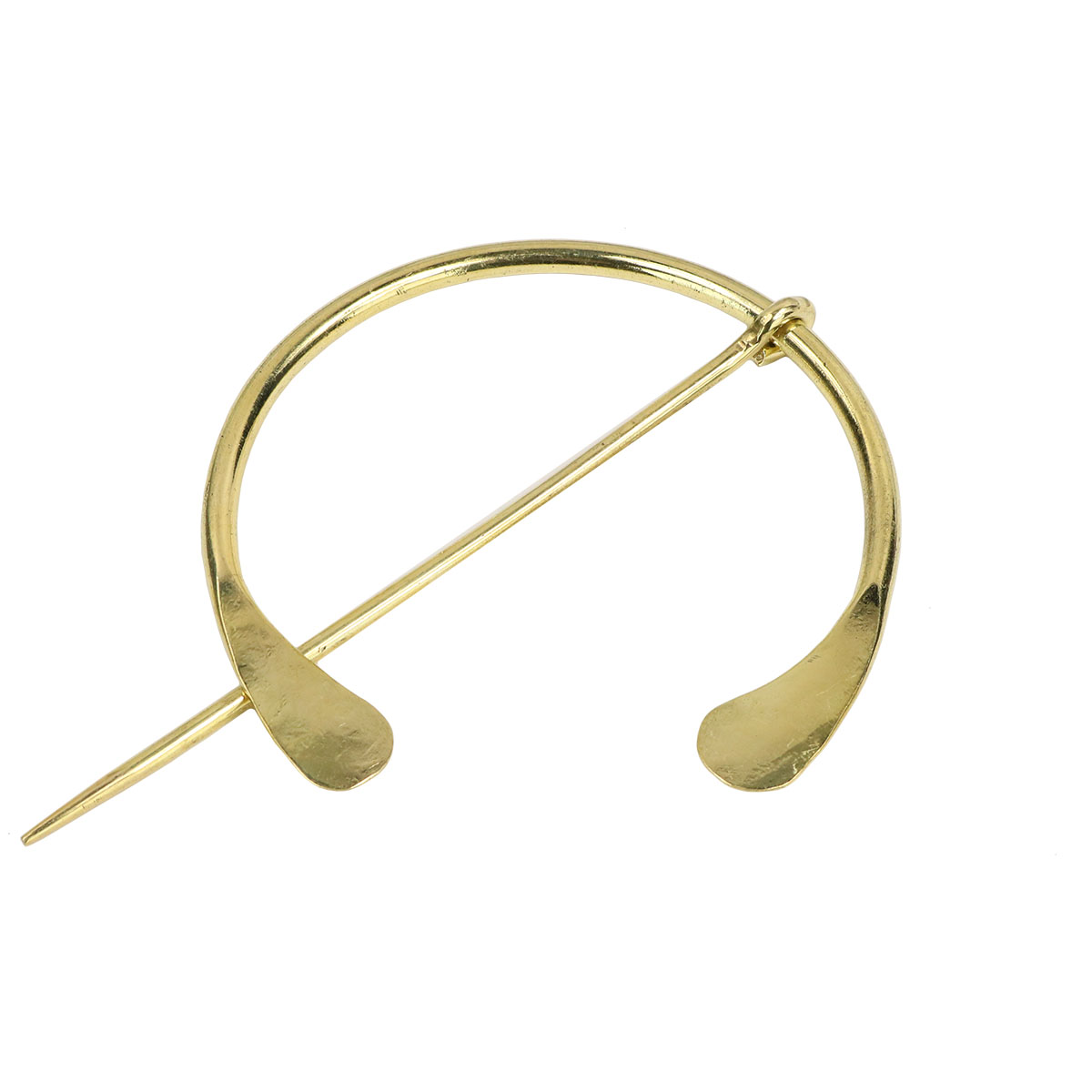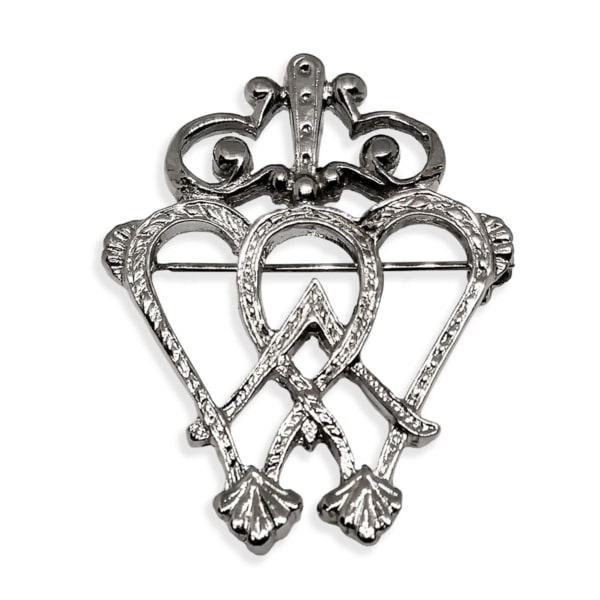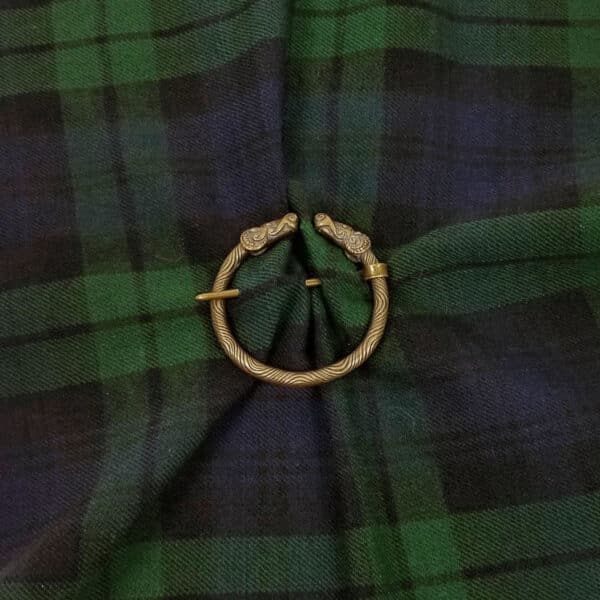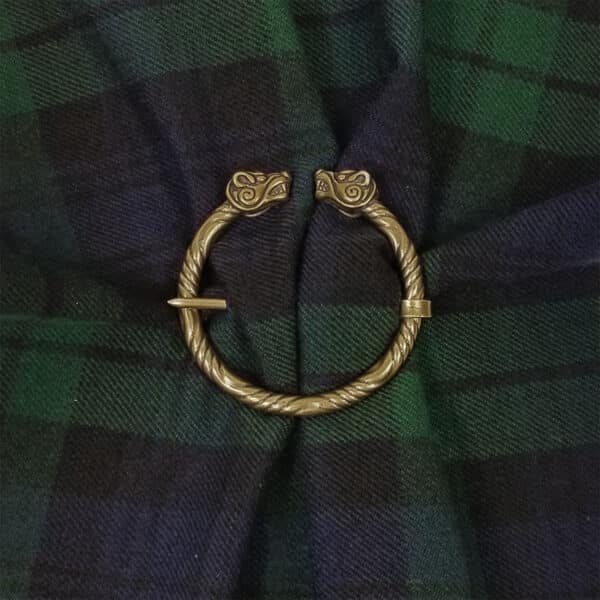Description
3-1/2 Inch Plain Brass Penannular Brooches
This 3 1/2 inch large brooch is perfect for great kilts, ancient kilts, fly plaids earasaids, Renaissance attire and more. If you’re looking for a penannular brooch that’s simple and functional, these are just what you need! They’re inexpensive, and they get the job done! Hand-formed and hammered brass in a traditional design.
- Simple and functional
- Inexpensive
- Gets the job done!
- Hand-formed and hammered brass
- Traditional penannular design
- Size Large: 3.5 inch diameter
The History of The Penannular Brooch
Also known as the “Celtic brooch”, the penannular brooch is used to fasten clothes. Our customers often use them to fasten fly plaids, the aprons of ancient kilts, and the extra fabric of great kilts. Jamie Fraser from OUTLANDER wears one to fasten his great kilt (one similar to our Wrought Iron brooch). The name comes from the fact that it is made of an incomplete ring. People associate them with the British Isles of the Early Medieval period the most.
People of Iron Age Europe first used them for the practical purpose of fastening clothing. Elites of Ireland and Scotland from 700-900 owned highly ornate brooches made of precious metal. They are the most significant non-religious metalwork from Early Medieval Celtic art. Celts continued to use more simple brooches, such as a thistle brooch, into the 11th century Viking age in Ireland and Scotland.
Both men and women wore these brooches. The men wore them at the shoulder and women at the breast with the pin pointing up. An Irish law stated that the wearer was not at fault for an injury sustained from the pin of a brooch if the pin is pointed up and does not project too far out.
Elites and clergy in Ireland wore the most elaborate brooches. The clergy likely wore them only for ceremonial purposes to fasten copes and other vestments. An Irish statute stated that sons of major kings that are fostered should wear gold brooches with crystal inserts. The sons of minor kings only needed to wear silver brooches. This means that our 3 Stone Penannular Brooch resembles those worn by the sons of major kings, because of the crystal inserts.





Leslie N. (verified owner) –
Absolutely lovely!
gene halberstadt (verified owner) –
Much larger than expected, but will take care of intended use
Joseph G. (verified owner) –
Excellent product ! Nice large size,but not too heavy. Pins a wool blanket easily without making a large hole.Works great for my needs !
Levi S (verified owner) –
I ordered this brooch with my Homespun Great Kilt. I chose this one as opposed to the wrought iron one because the tartan is a relatively dark one (Scottish National), and I figured this brooch would fit with it better than the other because of color contrast.
My complaint about the brooch is its poor workmanship. A) At either end of the main (thicker) shaft, the metal has been flattened, and at the edges of the flattened parts there are tool marks, probably either from a file or rough grit sandpaper. It should be sanded smooth with fine sandpaper and perhaps polished. B) There is also a tool mark remaining on the other wire. At the end that wraps around the main shaft, the wire has been cut with wire cutters, leaving an ugly pinch mark. It really should be filed/sanded flat. C) The metal is starting to turn dark from oxidation. It really should have a protective coat of some sort (Renaissance wax perhaps) to deter oxidation. D) There are a couple other minor points that would be too fussy to explain, but a craftsperson who is invested in and really cares about their craft should notice them.
Before I continue, I want to note that though perhaps I seem overly critical, I myself am an amateur jeweler and a perfectionist (two things that go together either very well or badly, depending on how you look at it), so I do notice and understand these things. Now on to the final item.
The previous complaints have all been cosmetic, but this last one and most important one is about functionality. E) The “pointy” end of the pin was far too blunt and the taper was too steep. I didn’t dare to use it without modifying it first, for fear it would burst some threads of the kilt. (In fact I am still somewhat wary, but now more because I think the wire is too thick.) As I noted above, I am an amateur jeweler, so I took a file and sandpaper and made the taper much more gradual and the point much more sharp. But really one should be able to use the product out of the box without fearing that it is going to damage the kilt.
Ultimately it’s nice that I have a brooch at all, but they should make it better.